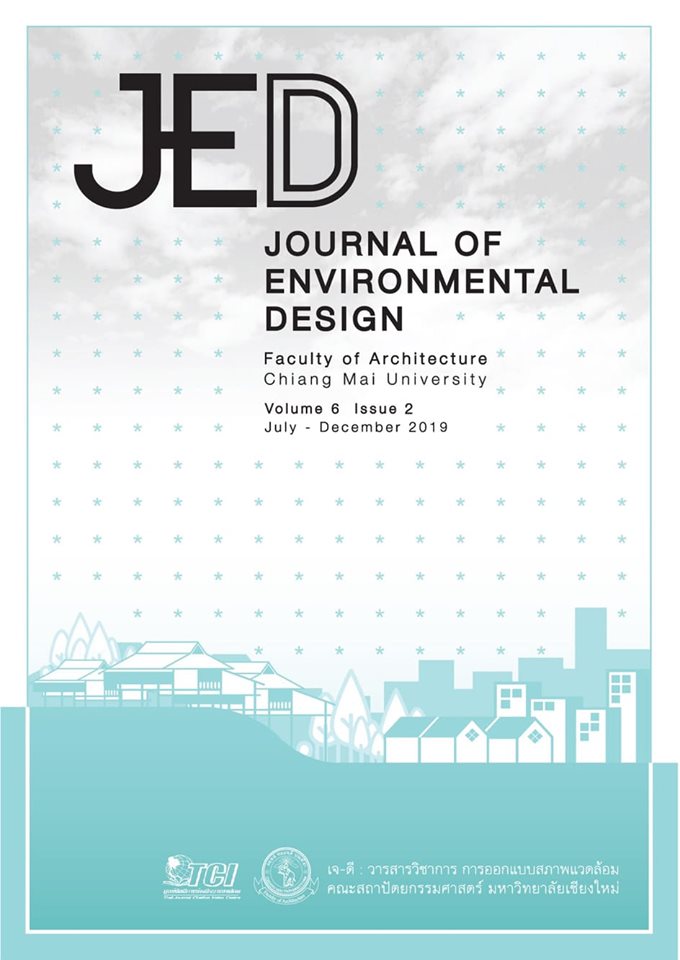Sea nomads’ mobile vernacular architecture: case studies of Moken ethnic group in Mu ko Surin, Phangnga province and Urak Lawoi ethnic group in Baan To - Baliew, ko Lanta Yai, Krabi province
Main Article Content
Abstract
This article aims to study about the sea nomads’ mobility settlement and architectural structure before changing from mobile to permanent settlement. The research process is based on a field study, focusing on 2 sea nomad groups namely; Moken ethnic group in Mu ko Surin in Phangnga province, and Urak Lawoi ethnic group in Baan To - Baliew, Mu ko Lanta Yai, Krabi province. The result shows that in the certain moment, sea nomad’s mobility settlement is the suitable way of life choice. Fruitful natural resources had been the key factor sea nomads decided to stay within their compact society, relying on hunting and gathering. They are mutual with the nature and rather adapt themselves than control it. When the sea nomads choose a settlement location, they will find a place to park their boats, remove and and fix the boats’ roofs using materials from the surroundings, transforming them into shelters. They will be on the sea again after the natural resources are reduced. Their temporary settlement is based on climate factor, especially during monsoon seasons. Moreover, sea Mokens’ boats and shelters have the architectural structure that responds to humans’ safe and convenient way of life, as a result of the relationship between humans, manmade structures and surroundings.
Article Details
References
Arunotai, N. (2006). Pracha sangkhom lae chumchon khemkhaeng nai boribot khong klum chai khop koranee sueksa klum chao le nai prathet Thai. (In Thai) [Civil society and community strength in the context of marginalized group: the case of sea nomads in Thailand]. Bangkok: Thailand Research Fund.
Arunotai, N. (2014). Taksa wattanatham chao le roi rueangrao chao le Moken Moklen lae Urak Lawoi phu kla haeng Andaman. (In Thai) [Cultural skill: many stories of Moken Moklen and Urak Lawoi the brave people of Andaman]. Bangkok: Princess Maha Chakri Sirindhorn Anthropology Centre.
Krainatee, M. (2009). Pattanakarn khong karn tang thinthan chumchon Urak Lawoi nai phuentee Phuket chak mum mong niwet wattanatham. (In Thai) [Development of Urak Lawoi community settlement in Phuket from cultural ecology perspective] (Master’s thesis). Bangkok: Chulalongkorn University.
Sadjarak, S. (2011). Neawtang karn songsoem karn rianru phuea raksa atta lak chao le Moken. (In Thai) [Approach to enhance learning on the preservation of Moken gypsies’ identity] (Doctoral dissertation). Bangkok: Silpakorn University.
Sopher, D. E. (1977). The sea nomads: a study of the maritime boat people of Southeast Asia. Singapore: National Museum.
Thaewchatturat, A. (2000). Phrueksasat phuenban khong chao Moken uthayan haeng mu ko Surin amphoe Khura Buri changwat Phangnga. (In Thai) [Ethnobotany of Moken at Moo Ko Surin national park, amphoe Khura Buri changwat Phangnga] (Master’s thesis). Bangkok: Kasetsart University.
Ukrisana, A. (1989). Phithi loi ruea phap sathon sangkhom lae wattanatham khong chao le koranee sueksa chumchon ban Hualaem ko Lanta changwat Krabi. (In Thai) [The boat floating ritual: a reflection of the social and cultural life of chao le a case study in ban Hua Laem, ko Lanta changwat Krabi, Thailand] (Master’s thesis). Bangkok: Silpakorn University.
Winthrop, R. H. (1991). Dictionary of concepts in cultural anthropology. New York: Greenwood.


